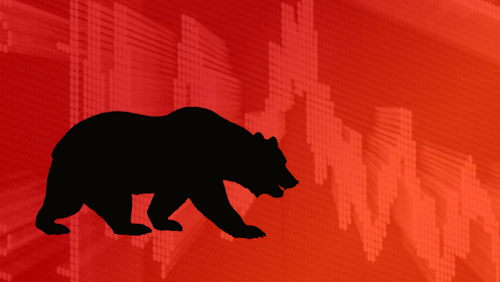

Summary
- The advent of a bear market always prompts questions about how bad it can get.
- Happily, few bear markets get much worse than a 20% selloff. But those preceded by bubble-fuelled markets tend to be super bear markets with declines of 40% and more.
- The pandemic rally was clearly a bubble. It took a bear market for the S&P 500 to return to something like fair value.
- Whether the bear will be satisfied with a big growl or is just waking up will depend on a host of geopolitical factors well out of most companies’ control.
This article is only available to Macro Hive subscribers. Sign-up to receive world-class macro analysis with a daily curated newsletter, podcast, original content from award-winning researchers, cross market strategy, equity insights, trade ideas, crypto flow frameworks, academic paper summaries, explanation and analysis of market-moving events, community investor chat room, and more.
Summary
- The advent of a bear market always prompts questions about how bad it can get.
- Happily, few bear markets get much worse than a 20% selloff. But those preceded by bubble-fuelled markets tend to be super bear markets with declines of 40% and more.
- The pandemic rally was clearly a bubble. It took a bear market for the S&P 500 to return to something like fair value.
- Whether the bear will be satisfied with a big growl or is just waking up will depend on a host of geopolitical factors well out of most companies’ control.
Market Implications
- The next milestone for equities will be 2Q earnings, starting in about a month.
- If the earnings momentum of recent quarters weakens (as we expect), the bear market will lurch further downward. Even good earnings will likely prompt a wait-and-see stance to determine how inflation and energy prices develop in coming months. Any rise in recession risk will add to the misery.
- We currently favour equities related to energy and commodities.
Introduction
The bear market has officially arrived. But is this the beginning of the end (meaning it gets little worse) or the end of the beginning (take cover while you can)? History since 1928 provides plenty of examples of both situations (Chart 1).

What Defines a Bear Market?
First things first. The standard definition of a bear market is a 20% selloff from a recent high. We have set a recent high as the high water mark up to a given date. Chart 1 shows there are cases of equities selling off by more than 20%, staging a partial recovery, then falling another 20%+. This happened particularly during the depression years, but also during more recent sharp drawdowns to less than 60% of the recent high.
Bear Markets and Recessions
Second, bear markets often – but do not always – occur shortly before or during recessions. There were several bear markets during the 1960s that were not associated with recessions. There have also been several recessions where equities did not breach (or only touched) the bear market standard. As massive as the implosion of the NASD dot-com bubble was, it ended in recession primarily because of the economic shock of the 9/11 attacks; absent that, it might have been solely a financial market debacle.
The good news for our purposes is that most people expect any recession to come some time in 2023 – implying that it is not inevitable at this point.
Hot Markets Beget Super Bear Markets
Third, and less auspiciously, the super bear markets of the 1930s, the early 1970s, 2001-02 and 2008-09 followed hot bubble-fuelled markets. Of course, these occurred in different eras with quite distinct facts and circumstances, so they are not directly comparable. Nevertheless, there is a clear pattern here.
We firmly believe the current bear market is yet another unwinding of a massive bubble (Chart 2). We revealed in recent articles a close relationship between earnings growth and the S&P 500 over the past 20 years (Chart 2). That relationship got seriously out of whack during the past two years of the Covid pandemic. A combination of rock-bottom rates and strong fiscal stimulus fuelled a massive equity rally. Arguably, equities are just returning to fair value relative to earnings expectations.

Equities Will Focus on 2Q Earnings
The big question now is whether analysts’ projections of 13-14% earnings growth over the next year are on the mark. If they are, we can argue this bear market may have largely run its course. There are good reasons why that might be the case:
- The economy and labour market are still strong.
- Many, if not most, companies and homeowners have locked in very low rate debt and mortgages and will be shielded from rising rates for the foreseeable future.
- Many previously overvalued companies now sport reasonable valuations. Google’s P/E is 19, versus a high of 31 last year. Apple’s P/E is 22 versus 31 last year. Netflix’s P/E is 17 versus 51 last year.
But even with these tailwinds, things could unravel.
During the recent earnings season, many companies expressed caution about their outlooks for the rest of 2022. Among other things, they were concerned about supply chains, rising commodity prices and their ability to pass them on, labour shortages, inflation, unpredictable consumers, and loss of markets due to the Russian invasion of Ukraine.
And then there is the Fed. So far, it is talking as if it is willing to drive the economy into recession if necessary to lower inflation.
This all amounts to considerable uncertainty about earnings and the economy.
Barring some new major economic shock, the next milestone for equities will be the 2Q earnings season starting in about a month. The key question is whether the earnings momentum of recent quarters shows signs of getting derailed. If earnings stay strong, markets could rally slightly. But they are unlikely to take off as long as the cloud of uncertainty outlined above remains in place. Particularly important will be how inflation and energy prices develop in coming months.
Should earnings start to crack or the recession risk becomes more than a statistical possibility, we look for another significant downturn in equities.
The Glass Is Half Empty
For now, that is our base case. We currently favour equities related to energy and commodities.
